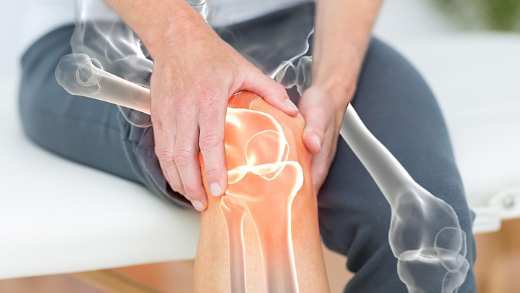Knee pain
Injury and repeated stress on the knee are two of the most common types of knee pain. Find out what you can do to treat yourself and when to get medical help.

Injury and repeated stress on the knee are often a cause of knee pain. But it’s not always an obvious injury that’s causing your pain.
So let’s take a closer look at what might causing your knee pain, and what you can do about it.
Symptoms of knee pain and when to see a doctor
You or your doctor will usually be able to work out what’s wrong with your knee as the symptoms may point to certain injuries, or another condition that can come on without much warning.
With an obvious injury
- Pain between your knee and shin while exercising is usually tendonitis
- If you’re unable to straighten your leg, or it’s giving way when you stand it could be a torn ligament or tendon. You may have heard a popping sound during an injury.
- If your knee is painful after overstretching, overusing or twisting it during exercise it may be a sprain or strain. Footnote [1]
- If your knee changes position after impact it will be immediately noticeable as a dislocated kneecap.
Without an obvious injury
- If you’re older and feeling pain and swelling in both knees it could be osteoarthritis.
- Pain when kneeling or bending and a warm sensation and redness where you can feel the pain is often a symptom of bursitis.
- If you’re experiencing swelling, warmth and bruising it could be bleeding in your joint.
- Sudden and intense pain and hotness in the immediate area around the pain can be gout or septic arthritis.
- If you’re a teenager or young adult with pain and swelling below the kneecap it could be Osgood Schlatter disease.
You’ll need to see a doctor if your knee pain doesn’t get better within a few weeks and it’s very painful, and/or swollen so badly that you can’t move it or put any weight on it.
Call 111 for advice if your knee has changed shape, you have a high temperature and there’s redness or heat around your knee (possible infection), or if your knee locks and clicks with pain.Footnote [2]
Diagnosis of knee condition
Your doctor may need to send you for a scan to get to the bottom of what’s causing your knee pain. This could be an MRI scan to look at the soft tissue around the knee, an X-ray, which will show obviously broken bones, a CT scan for more detailed images of fractures, or ultrasound which can be used to look at the movements of your knee.
A combination of your symptoms and any scan results will help your doctor diagnose the problem. Some of the disorders are:
Patellofemoral Pain Syndrome (PFPS)
One type of pain is at the front of your knee or behind your knee cap. When you bend your leg, your kneecap slides along a groove at the end of your thigh bone.
If there’s repeated stress or an issue with alignment, then it can be painful. You may have heard of ‘runners knee’ - it’s the same thing and tends to happen with people who are really active.
- If you’re experiencing any of these then you might have PFPS:
- A dull, aching sensation, especially if it’s behind or around your knee.
- Pain that worsens when you bend you knee – walking, running, or climbing stairs.
- Walking downhill or downstairs when you’re putting more pressure on your knees.
- Feeling a popping or grinding sensation when bending your knee.
- Swelling or tenderness, particularly around the kneecap.
Bursitis knee
Bursitis knee is inflammation of bursas which are small fluid-filled sacs in your knee. The bursas act as a cushion between bones and soft tissue, reducing friction and allowing smooth movement.
If you’re experiencing any of the following it might be a sign of bursitis knee:
- Pain and tenderness around the affected bursa.
- Swelling and warmth.
- Limited range of motion.
- Discomfort exacerbated by kneeling or bending the knee.
Prolonged kneeling and repetitive movements are often the cause during activities like gardening or certain sports.
Tendonitis knee
Tendonitis knee is inflammation of the tendon that connects your kneecap to your shinbone. It’s frequently caused by overuse or repetitive stress on the knee joint, especially in activities that involve jumping or quick changes in direction.
These are some of the symptoms of tendonitis knee:
- Pain around the front of your knee, just below the kneecap.
- Swelling and tenderness around the affected area.
- Stiffness in your knee, especially after periods of inactivity.
- Worsening pain during activities like running, jumping, or kneeling.
Osgood Schlatter disease
Osgood-Schlatter disease is a condition that primarily affects children, especially those who are physically active and going through growth spurts. It happens when the tendon that attaches the kneecap to the shinbone is pulled, and can cause pain in the raised bone in front of the knee.
Fortunately any tenderness and swelling almost always stops as the growth spurt ends. But it’s wise to take a rest from high impact activities like running if the knee has flared up.
It’s OK to use ice packs to cool the area and help with swelling, and you can take medication like ibuprofen but we’d always recommend speaking with a doctor first.
Common treatments for knee pain
There are several treatments for knee pain, depending on what’s wrong with your knee.
What you can do yourself:
- Rest your knee and give it time to heal.
- Avoid activities that make the pain worse.
- Apply ice to reduce swelling and numb the pain.
- Raise your leg when resting to reduce swelling.
Medicines that help:
Painkillers like paracetamol and anti-inflammatories will help reduce pain and inflammation in your knee. They can have side effects and so you’d need to speak with a doctor first.
You might also be offered a steroid – or corticosteroid injection as it’s also known - in your knee to help reduce inflammation and pain, especially if you have arthritis or bursitis.
Physiotherapy:
Physiotherapy plays a crucial role in managing and treating knee pain. You'd be given specific exercises to do to strengthen the muscles around your knee. The exercises are designed to help provide better support and reduce stress on your knee joint.
Surgery:
If you have a major condition or injury affecting your knee, or other treatments haven’t worked, then you might need surgery on your knee.
Knee reconstruction
One of the most common types of knee reconstruction is surgery to repair your anterior cruciate ligament (ACL). The ACL is a band of tissue joining your thigh bone to your shin bone through the knee. It gives you back and forth movement of your lower leg and if you tear it, you might need reconstructive surgery to repair the damage.
Knee replacement
One of the reasons for a knee replacement, is to cure pain and movement problems caused by osteoarthritis (the condition that causes your joints to become painful and stiff).
There are two types of knee replacement:
- Total knee replacement (TKR): It’s the most common type of knee replacement. The lower end of your thigh bone and the upper end of your shin bone are replaced with metal and plastic parts.
- Partial knee replacement (PKR): is common when if you have arthritis in one half of your knee. Only the bones on the affected side are replaced with metal or plastic parts
Preventing knee pain and injuries
There’s lots of ways you can prevent pain and injury to your knees but bear in mind that your age, genetics, lifestyle, and previous injuries can influence the risk of knee pain.
- Maintain a healthy weight: excess weight puts additional stress on your joints and increases the risk of knee problems and arthritis.
- Stay active with regular exercise: regular exercise strengthens the muscles in your knees and improves overall joint health.
- Warm-up: gentle stretching before exercise warms up your muscles lessens the risk of injury.
- Proper technique: whether you’re running or jumping, using the proper technique reduces the risk of knee injuries. Consult with a fitness professional to make sure you’re using the correct form.
- Listen to your body: don’t ignore discomfort or pain during physical activities. If you’re feeling persistent knee pain, speak with your doctor.
- Avoid high-impact activities if at risk: If you have a history of knee problems or are at risk of knee injuries, consider low-impact exercises such as swimming or cycling.
Use your cover to pay for your treatment for knee pain
If you have health insurance in place and you develop knee pain you'll be able to get it looked at quickly and easily.
The first step is to get a referral from your GP, or through our Digital GP app^. Then you can make a claim through MyAviva, over the phone, or online.
Once we’ve confirmed your claim meets the terms of your policy, we’ll pay for the treatment directly. Just be sure to tell us if you need more tests or treatment, or if your hospital or specialist changes.
You'll also be given access to our knee treatment network - a specially selected group of experts offering quality treatment for the knee from initial consultation and diagnosis through to treatment and recovery for selected knee condition. And that’s at no extra cost, with two years of aftercare included.
It’s good to have one less thing to worry about. It takes Aviva.
^ These services are non-contractual and can be withdrawn or amended by Aviva at any time.
Next article
Worried about GP and hospital wait times?
Here's how quickly you could get treated with health insurance.



